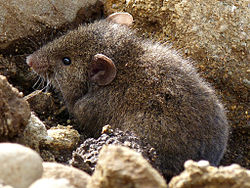| Abrothrix sanborni | |
|---|---|
 | |
| Scientific classification | |
| Kingdom: | Animalia |
| Phylum: | Chordata |
| Class: | Mammalia |
| Order: | Rodentia |
| Family: | Cricetidae |
| Subfamily: | Sigmodontinae |
| Genus: | Abrothrix |
| Species: | A. sanborni |
| Binomial name | |
| Abrothrix sanborni (Osgood, 1943) | |
| Synonyms | |
| |
Abrothrix sanborni, also known as Sanborn's grass mouse [1] or Sanborn's akodont, [2] is a species of rodent in the genus Abrothrix of family Cricetidae. It is found in southern Argentina and Chile, but may not be distinct from A. longipilis . [1]
